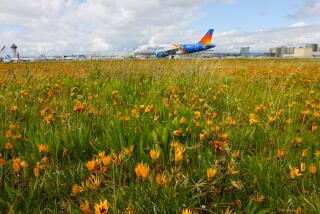Californians can’t seem to stop loving nature without destroying it
It’s pretty fantastic that a bumper crop of butterflies and fields of flowers have inspired so many people to turn off their screens and enjoy the show that Mother Nature puts on for free all the time.
But, really, why must some people show their appreciation for nature by destroying it?
That’s apparently been the case out at Walker Canyon near Lake Elsinore, where hordes of people have traveled many miles in their climate-changing machines to see the colorful poppy-covered hills — and then trample through the delicate blooms. The crowds and traffic got so bad that Lake Elsinore city officials shut down access to the canyon Sunday. That’s only a temporary reprieve, and as spring hasn’t quite sprung, there will be likely more super bloom carnage to come here and in places like the high desert and Anza-Borrego Desert State Park.
It’s a sad fact that nature has to be protected from humans who might otherwise love it to death. During the government shutdown earlier this year, the national parks remained open to visitors, though their rangers and other staff were furloughed. Many of those who traveled to Yosemite or Joshua Tree national parks (probably in a gasoline-powered vehicle) to enjoy their unspoiled loveliness without having to pay the usual entrance fee thanked the park service by dumping trash among the cacti or pine trees and otherwise destroying the environment. (The Los Angeles Times editorial board was appalled at the bad behavior and urged the national parks to be shut down until the government was reopened.)
Enter the Fray: First takes on the news of the minute »
Even when humans aren’t squashing flowers or leaving their fast food wrappers (and worse) behind, there’s something perverse about how we experience nature. When the super bloom of 2017 enticed thousands of people to pile into their cars and burn gallons of gasoline just to view some flowers, I couldn’t help but wonder how many tons of carbon dioxide were added to the atmosphere by all the flower tourists, and what that meant for future super blooms.
What’s more, you don’t need to drive for an hour or two to see some great flower action this year. It’s all around us. Look at your own neighborhood. The poppies are popping right now in my dense and urban Los Angeles neighborhood, along busy sidewalks and freeways. And if your neighborhood is bereft of flowers, you can fix that next year by buying some native wildflower seeds now and planting them around your yard.
But if you just can’t stay away and must join the crowds to see the blooms this year, then at least take a minute to consider the sage advice imparted in the video posted below.

More to Read
A cure for the common opinion
Get thought-provoking perspectives with our weekly newsletter.
You may occasionally receive promotional content from the Los Angeles Times.







